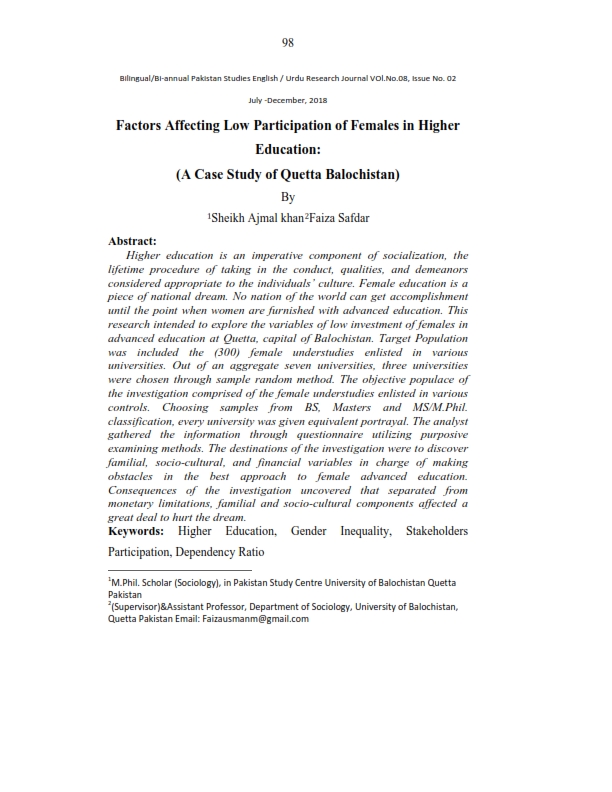Factors Affecting Low Participation of Females in Higher Education (A Case Study of Quetta Balochistan)
Keywords:
Higher Education, Gender Inequality, Stakeholders Participation, Dependency RatioAbstract
Higher education is an imperative component of socialization, the
lifetime procedure of taking in the conduct, qualities, and demeanors
considered appropriate to the individuals’ culture. Female education is a
piece of national dream. No nation of the world can get accomplishment
until the point when women are furnished with advanced education. This
research intended to explore the variables of low investment of females in
advanced education at Quetta, capital of Balochistan. Target Population
was included the (300) female understudies enlisted in various
universities. Out of an aggregate seven universities, three universities
were chosen through sample random method. The objective populace of
the investigation comprised of the female understudies enlisted in various
controls. Choosing samples from BS, Masters and MS/M.Phil.
classification, every university was given equivalent portrayal. The analyst
gathered the information through questionnaire utilizing purposive
examining methods. The destinations of the investigation were to discover
familial, socio-cultural, and financial variables in charge of making
obstacles in the best approach to female advanced education.
Consequences of the investigation uncovered that separated from
monetary limitations, familial and socio-cultural components affected a
great deal to hurt the dream.
References
Abu-Ghaida, D. and S. Klasen. (2004). The Costs of Missing the
Millennium Development Goals on Gender Equity. World
Development, Vol.32, No.7, pp.1075-1107.
Addy, Esi,Sutherland. (2008). Gender Equality in juniors and Senior
Secondary Education in Sub-Saharan Africa. The International
Bank for Reconstruction and Development. The World Bank.
Alderman, H. and E.M. King. (1998). Gender Differences in Parental
Investment in Education. Structural Change and Economic
Dynamics, Vol.9, No.4, pp.453-468.
Ally. (2007) “Education in Pakistan: A White paper (Revised). Document
to debate and finalize the National Education Policy. Islamabad:
Government of Pakistan, National Education Policy Review Team.
Chitrakar (2007). Overcoming Barriers to Girls Education in South Asia.
United Nations Child Fund. Education for All. Regional office of
South Asia, Nepal.
Coleman,David. (2004). Overview of Minority migration. In: Iredale, R.,
Bilik, N., Guo, F. (Eds.). China’s Minoritis on the Move: Selected
Case Studies, M.E. Shape, New York.
Deze, J. & Murthi, M. (2001). Fertility, education and development;
evidence from India. Population and Development Review, 27 (1),
-63
Dewey, John. (1944). Democracy and Education. The Free Press. pp. 1–4.
ISBN 0-684-83631-9
Hill, M.A., and E. M. King. (1995). Women’s Education and Economic
Well Being. Feminist Economics, Vol.1, No.2, pp.21-46.
Hill, M.A. & King, E. (1995). Women education and economic wellbeing. Feminist Economics, 1; 2, 21-46.
Inayatullah, A. (1996). Women and University Curriculum, Jessica
Kingsley Publisher, United Kingdom
Jehan, R. (1996). The Exclusive Agenda: Mainstreaming Women in
Development. The Pakistan Development Review, Vol.35, No.4,
pp.825-834.
Kenny, M. E. (1990). College senior’s perceptions of parental
attachments. The value and stability of family ties. Journal of
College Student Development, 31, 39-46.
Kramarae, P.M, Cheris. And S, Dale (2000). Routledge international
Encyclopedia of women. vol 2. Routledge. New York’s.
Klasen, Stephan. (2002). Low Schooling for Girls, Slower Growth for All?
Cross Country evidence on the Effect of Gender Inequality in
Education on Economic Development. The World Bank Economic
Review, Vol.16, No.3, pp.245-373.
The World Bank (2006). Pakistan: An Assessment of the Medium-Term
Development Framework, Higher Education Policy Note, Report
No. 37247, Human Development Sector, South Asia Region.
Tembon, M. and Fort, L. (2008). Girls’ education in the 21st century. The
International bank for The Reconstruction and Development. The
World Bank, Washington DC.



